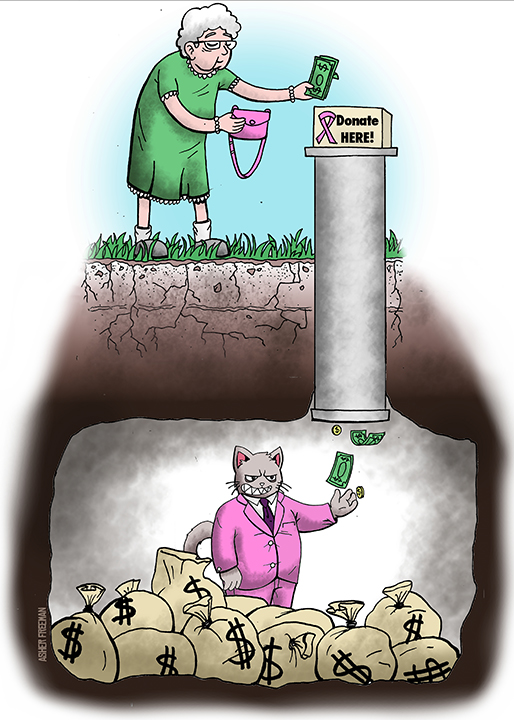 It’s October, and that means it’s breast cancer awareness month. Cancer is a horrible disease that scientists will hopefully find a cure for soon, and during breast cancer awareness month, people are called to donate toward research organizations.
It’s October, and that means it’s breast cancer awareness month. Cancer is a horrible disease that scientists will hopefully find a cure for soon, and during breast cancer awareness month, people are called to donate toward research organizations.
Some organizations, however, have turned these pink ribbons into green stacks of cash.
The NFL gives its players pink gloves, shoes, towels and equipment to draw attention to breast cancer. To raise money, the NFL started “A Crucial Catch,” a program that sells pink NFL accessories, apparel and regular items donned with the famous pink ribbon.
One hundred percent of the net proceeds are donated to the American Cancer Society, according to the NFL.
What the NFL does not tell you is what ESPN’s Darren Rovell released.
For every $100 in pink NFL gear sold, $50 goes to the retailer, $37.50 goes to the manufacturer and the NFL takes $1.25.
This leaves $11.25 for the American Cancer Society, but the buck doesn’t stop there.
Of that original $100, only $8.01 goes toward actual cancer research. The rest goes to the American Cancer Society’s other expenses.
The NFL is drawing a lot of attention toward breast cancer, and that is certainly admirable. Now the league just needs to put its money where its mouth is.
This means it needs to stop making a profit off of breast cancer awareness and start pushing part of its own revenue, which Forbes estimates will be more than $9 billion, toward the cause.
The American Cancer Society doesn’t get off scot-free either. According to the Charity Navigator website, the American Cancer Society uses 71.2 percent of its income to fund actual research and services related to breast cancer.
While we applaud the company for being transparent with how its money is allocated, it needs to funnel more money into research and services.
Charity Watch claims that the American Cancer Society CEO John R. Seffrin received $2.4 million in compensation in the 2009-2010 fiscal year.
The American Cancer Society spent nearly $20 million more than it took in, and this forced the company to reassess how it distributes money.
According to its most recent 990 IRS filings, Seffrin’s compensation is down to more than $832,000.
Some say that this is still too much for a nonprofit company. New York, New Jersey, Florida and Massachusetts have all attempted to put a cap on highly compensated employees at nonprofit organizations that receive public funding. Massachusetts attempted to cap executive pay at $500,000.
Florida took this a lot further and tried to set its cap at $130,000. No such legislation has gotten enough support to become law, however.
While Seffrin’s pay was slashed, another highly compensated employee received a raise.
According to the organization’s 990 IRS filings, Nancy Brinker, founder and chair of Global Strategy for Susan G. Komen, received $417,000 for the 2010-2011 fiscal year, but the company decided to raise her total compensation to $696,717.
Unfortunately, this problem of highly compensated employees extends to many more charities.
According to Bloomberg, CEOs of the largest U.S. foundations and charities receive an average annual compensation of nearly $430,000, and this number is trending upward.
In theory, these organizations exist to help those impacted by cancer. In practice, they are profiting off caring people who want to help.
Cancer is not a business. If you would like to help people in need instead of pouring money into greedy pockets, do your homework and find out where your money is actually going. The Charity Navigator website will give you a breakdown of how a charity allocates its funds.
Find a responsible charity and donate to it.
In the case of the NFL, the American Cancer Society and Susan G. Komen, you won’t like where your money goes.






